Job creation and higher living standards have long been key objectives for the Chinese government. However, millions of workers in traditional industries are being laid off and many of the new jobs being created are insecure and poorly paid. The legal framework established ten years ago to protect workers has largely failed to do so, to the extent that millions of workers cannot even be sure they will get paid on time.
The minimum wage has risen steadily over the last decade but there are substantial regional differences and it has not kept pace with increases in the cost of living, especially in major cities. The gap between the rich and poor in China continues to grow and despite long-standing government policies to reduce poverty, the urban and rural divide remains stubbornly in place.
Legal provisions on employment and the payment of wages
China has a comprehensive legal framework that defines the rights and obligations of employers and employees, primarily the 1995 Labour Law and the 2008 Labour Contract Law (amended 2013), which contain clear provisions on employment contracts, working hours and payment of wages, benefits and the termination of employment, specifically:
- Employers are required to conclude a written employment contract with employees (Labour Contract Law Article 10).
- The employment contract shall specify the term of the contract, the job description and place of work, working hours, rest and leave, labour remuneration, work safety protection etc. (Labour Contract Law Article 17).
- The standard workweek in China is 40 hours (eight hours per day, five days per week) although flexible working hours are allowed under certain conditions (State Council 1995 Provisions on Working Hours of Staff and Workers).
- Overtime shall be paid for any work exceeding standard working hours and overtime shall not exceed three hours a day or 36 hours per month (Labour Law Article 41).
- Overtime pay should not be less than 150 percent of an employee’s wages during normal work days; 200 percent on rest days, and 300 percent on national holidays, such as the Lunar New Year (Labour Law Article 44).
- Wages shall be paid in legal tender to the workers in person on a monthly basis. No deduction of wages for personal gain may be made from wages due to workers. The payment of wages may not be delayed without reason (Labour Law Article 50).
- An employer shall pay wages to workers during their statutory holidays, marriage or funeral leave (Labour Law Article 51).
- If their contract is terminated, employees are entitled to severance pay based on the number of years employed at a rate of one month’s wage for each full year worked (Labour Contract Law Article 47).
The erosion of legal protection
These provisions give workers a broad range of rights and a reasonable level of legal protection. However, ever since the Labour Contract Law went into effect on 1 January 2008, employers have sought to undermine it and local government officials have failed to implement it effectively, leaving it up to employees themselves to defend their rights either through the arbitration and the court system or by collective action.
By far the most common employer response to the implementation of the Labour Contract Law was to reassign existing employees and hire new employees as agency workers (劳务派遣) rather than as formal employees. This was seen as a way to reduce the benefits companies had to pay and make hiring and firing easier. Abuse of the system was so rampant that in 2013, the government sought to tighten loopholes in the law and ensure that only a limited number of “temporary, auxiliary or substitute” staff could be employed as agency labour. Nevertheless, many employers continued to employ staff as agency workers, denying them the same pay and conditions as regular employees. By the end of 2016, more than a thousand agency workers at FAW-Volkswagen, a Sino-German car manufacturing joint-venture in the north-eastern city of Changchun, had had enough and filed a complaint with the trade union demanding equal pay for equal work. Despite taking collective action and going to arbitration, the workers grievances remained unresolved more than one year later.
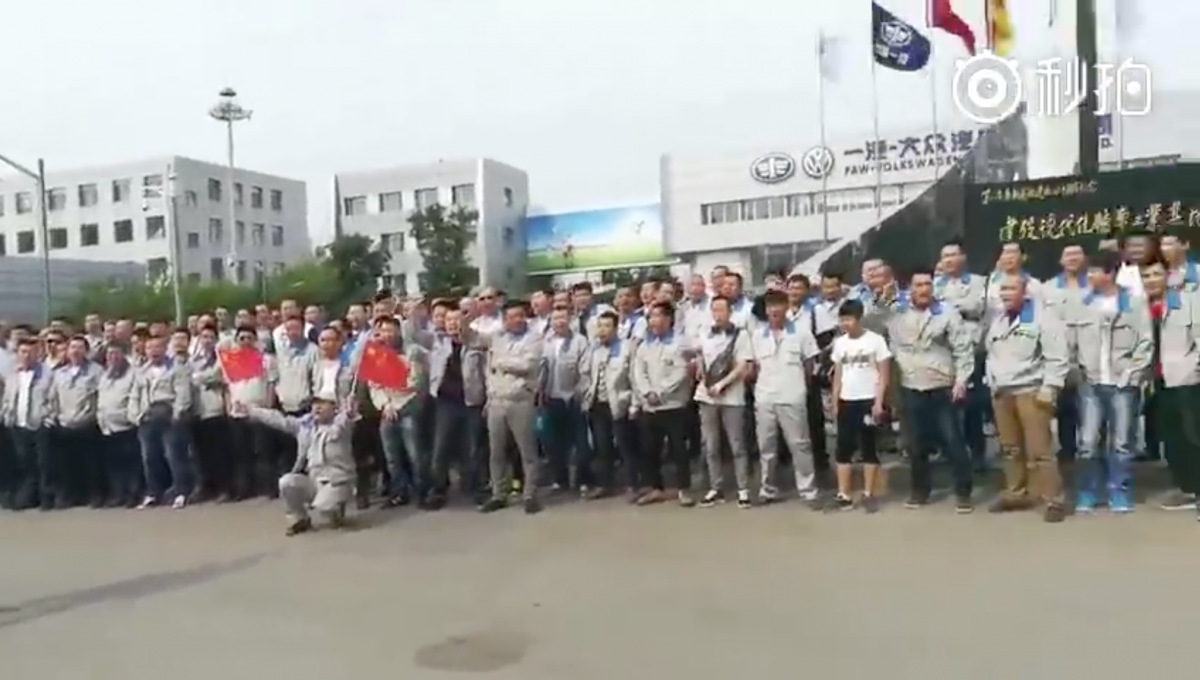
FAW-Volkswagen agency workers stage a protest at the plant in Changchun in May 2017
Other employers have sought to reduce costs by introducing flexible work-hours schemes and erode the protection provided by the standard workweek. In May 2016, American retail giant Walmart imposed a so called “comprehensive working hours system” on its roughly 100,000 employees in China. The move (almost certainly illegal under existing provisions) allowed the company to schedule working hours according to its own needs, reduce overtime and other benefits as well prevent already low-paid employees from holding down a second job. Walmart workers responded with strikes, legal action and widespread online resistance.
Other companies, especially in the manufacturing sector, seek to overcome legal restrictions on labour contracts by hiring student interns from vocational schools to meet demand during peak production periods. One of the most notorious employers of student labour is electronics manufacturer Foxconn, which most recently recruited 3,000 interns from the Zhengzhou Urban Rail Transit School in September 2017 in order to catch up with orders after a shortage of workers caused delays in production of Apple’s iPhone X. For most students, this factory work has nothing to do with their elected courses but they are often told they will not be allowed to graduate unless they participate in the program.
Many workers in the new service industries, in particular e-commerce and the sharing economy, do not have proper employment contracts but are instead hired as individual contractors with little or no job security and none of the welfare and social security benefits those with formal employment contracts are entitled to. The multi-billion dollar food delivery business, for example, is increasingly adopting an informal relationship with individual contractors who bid for delivery orders via smartphone apps without signing any formal contract with the company.
Terms and conditions of employment for many workers in these new service industries can be changed at short notice, as can payment rates, and the intense competition for customers has led to numerous business failures with workers being laid off without any compensation.
Job creation and labour market imbalances
The Chinese government has a longstanding commitment to job creation, seeing it as an essential component in maintaining social and economic stability. The government claims to have created about 13 million jobs in urban areas each year on average over the last five years and kept unemployment largely under control.
Although China’s working age population (16 to 59 years-old) has been contracting since 2012, the labour force has continued to gradually expand to stand at 807 million in 2016, up from 789 million in 2012. This suggests that more people who were previously excluded from the workforce (or certain sectors of the workforce) have been able to find employment as the economy has expanded and new employment opportunities opened up.
The problem is not the lack of new jobs it is rather that many of the new jobs being created are poorly paid, insecure and require employees to work long hours in often dangerous conditions. The vast army of couriers delivering packages from online shopping networks are an obvious example of the new employment opportunities and problems in China. One courier described how they “work 12 hours each day, delivering more than 300 items per day.”
We sort several tons of packages, even the lightest loads are around seven or eight kilograms. Every day I cover more than 40 kilometres and climb over 46 flights of stairs, and all the time my phone must be on 24 hours a day. I need to pay for all my calls myself. My average monthly wage is around 3,400 yuan.
The key issue for Chinese government officials and economic planners is not how many jobs are created but the extent to which employers can provide employees with decent, reasonably-paid jobs with the opportunity for career advancement.

Young job seekers examine their options in Shenzhen’s Longhua factory district
In addition, China’s labour market has long-struggled to provide employers with the well-trained and competent workers they need to make their businesses grow. The mismatch between the needs of job seekers and employers has been highlighted on numerous occasions over the last few years, especially whenever new college graduates enter the job market. Nearly eight million graduates entered the job market in 2017 with high expectations but little chance of finding a suitable position. Most graduates end up in relatively low-paid positions with salaries that could have been attained by going to work in a factory straight out of high school. A survey of new graduates working in manufacturing in the southern city of Foshan in 2017, for example, showed that their average monthly salary was just 3,614 yuan.
China’s academic, examination-orientated college system routinely fails to prepare students for the demands of the employment market. Vocational schools have likewise long been criticized for not producing the skilled or semi-skilled workers businesses need. However attempts by the government to make the system more effective by promoting privatization and encouraging greater corporate involvement have yet to yield any positive results.
Another major problem is the fact that many businesses are reluctant to invest any time or resources in training; rather they expect new staff to have all the skills they need to perform their jobs straight away. The view of many business owners is that providing training to their own staff will only encourage them to look for a better paying job elsewhere. This short-sighted view will have to change if China is to bridge the skills gap that is stalling the transition from a low-wage to a skills-based economy.
Some manufacturers and logistics businesses are looking to resolve their staff recruitment and training problems by turning to automation. However, despite the boom in robotics manufacturing, finding positions that robots can do instead of people has proved more difficult than expected. Even, Foxconn, the best-known proponent of robot workers, has scaled back its automation plans. The company’s enigmatic boss Terry Gou wanted to have one million robots in place by 2013 but in 2015, the general manager of Foxconn’s automation technology development committee, Day Chia-Peng, revealed that the company had only about 50,000 fully operational industrial robots installed in its Chinese factories. He said the company planned to add at least another 10,000 robots each year for the next five years to its facilities in China, replacing staff in the so-called “3D” jobs – positions that are dirty, dangerous and dull. The company’s much revised and much more realistic target is now to achieve 30 percent automation in its Chinese factories by 2020.
Managing unemployment
Throughout much of the 2010s, China’s official unemployment rate hovered steadily around four percent and the number of unemployed persons remained stable at around nine million. This rigidity stemmed from the very narrow base the statistics were drawn from. Only workers with an urban household registration (about half the total workforce) were included in the data, and the unemployment rate only referred to the proportion of officially registered urban job-seekers to the total number of employed urban workers. It ignored all rural workers and rural migrant workers, foreign workers, as well as those in insecure, part-time or casual work.
These statistics were widely acknowledged as being next to useless in gauging the true state of unemployment in China, so in 2018 the National Bureau of Statistics introduced a new system based on monthly surveys of workers in urban areas, reportedly based on International Labour Organization (ILO) standards. The first survey results put the overall urban unemployment rates for January, February and March 2018 at 5.0, 5.0 and 5.1 percent respectively. The rate in the 31 major cities surveyed was slightly lower; 4.9, 4.8 and 4.9 percent in the first three months. By way of comparison, China’s overall rate is still lower than both the average unemployment rate in developing countries (5.5 percent) and developed countries (6.6 percent).
While the new survey method is certainly an improvement on the previous official unemployment rate, it still does not represent the whole picture. Rural unemployment is not included and importantly neither are people in short-term or precarious employment who make up an increasingly large proportion of the urban working population.
That said, the authorities have taken some practical steps to ensure that China’s actual unemployment rate does not get out of hand. In laying-off up to six million workers in heavy industries such coal and iron and steel, local governments have taken a very cautious approach, setting aside 100 billion yuan for early retirement schemes and retraining programs. The number of employees at Ma’anshan Iron and Steel (Masteel) in Anhui, for example, has fallen from a peak of 90,000 to just 32,000. The cradle to grave benefits workers enjoyed in the era of the planned economy have long gone but as former Masteel worker Zhang Lijuan told the Financial Times, “The state will not let anyone be completely let go.” Laid-off workers have been offered decent early retirement packages and have a guaranteed pension when they reach retirement age. For many older workers the package is enough to live on while younger workers can supplement their income with flexible work using on-demand apps for delivery or ride hailing services.
Wage arrears
Most laid-off workers however are not as lucky as those from state-owned enterprises like Masteel. Workers in the private sector often struggle to get the compensation and social insurance benefits they are entitled to under the law and, in many cases, they are owed several months’ wages when made redundant, which they struggle to recover.
The non-payment of wages is by far the most important single cause of labour disputes in China today, not just for laid-off workers but employees in many sectors of the economy where the payment of monthly wages is not guaranteed. About 80 percent of all the collective protests recorded on China Labour Bulletin’s Strike Map in 2017 were related at least in part to wage arrears. In the construction industry, where the non-payment of wages is endemic, around 99 percent of all disputes are caused by wage arrears.
Chinese government officials are well aware of this chronic issue, admitting that the “deep rooted conflict” in the construction sector remains unresolved and acknowledging moreover that the problem is spreading to other industries. In a People’s Daily report in January 2017, a Ministry of Human Resources and Social Security (MOHRSS) official noted that:
On the one hand, the legacy issues plaguing the construction and manufacturing sectors haven’t been rooted out and disputes over wage arrears keep occurring at high intensities, on the other hand new economic sectors like e-commerce are following the same path.
The official blamed market uncertainties, rapid expansion and consolidation, and the growth of precarious work for aggravating the situation in the new economy.
The MOHRSS has proposed several measures to address the problem and even issued a 2020 deadline to “basically eradicate wage arrears.” However most proposals are simply administrative or judicial measures design to mitigate the failings of employers rather than tackle the fundamental imbalance in labour relations that allows employers to not sign formal employment contracts and delay payment of wages whenever they see fit.
Minimum wage levels
Minimum wage rates in China are determined by regional governments, based on local living costs, local wages and the overall supply and demand for labour. As a result, there is considerable variation in minimum wage levels in major cities and poorer rural areas. The highest monthly minimum wage as of July 2018 was in Shanghai (2,420 yuan), which was roughly double the minimum wage in smaller cities in provinces such as Hunan, Hubei, Liaoning and Heilongjiang.
Minimum wage rates in major cities such as Beijing, Shanghai and Shenzhen have doubled since China emerged from the global economic slowdown in 2010. Rates of increase in many other provinces however have not kept pace and the gap between the major cities and smaller urban areas has continued to grow (see graph below). In 2010, for example, minimum wage rates in Beijing and the manufacturing hub of Dongguan were basically the same but in 2018, the monthly minimum wage in Beijing was nearly 300 yuan higher than in Dongguan, even after a belated 210-yuan hike in Dongguan’s monthly rate in July 2018.
Monthly minimum wage rates in selected cities 2010-2018
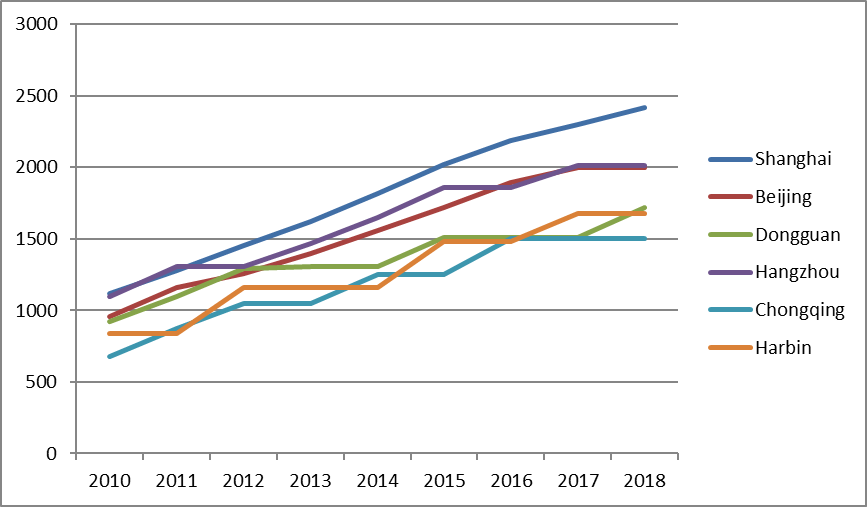
The slower minimum wage growth in Dongguan is partly explained by the desire of the Guangdong provincial government to slow the outflow of business, particularly manufacturing, to other countries and the Chinese interior where costs are lower. The policy has severely impacted the lives of low-paid workers across the province, according to a survey conducted the Hong Kong-based group Worker Empowerment in 2017. The majority of workers surveyed earned not much more than the minimum wage and as a result struggled to maintain even a basic existence. They were forced to live in low-rent poor quality housing, spent most of their income on food and many walked to and from work in order to avoid transport costs. Worker Empowerment estimated that a more realistic minimum wage in 2017 would be 2,970 yuan per month in Guangzhou; 1,922 yuan in Dongguan; 2,159 yuan in third-tier cities like Huizhou; and a minimum of 1,884 yuan in fourth-tier cities like Heyuan.
China’s Minimum Wage Regulations implemented by the then Ministry of Labour and Social Security in March 2004, stipulate that each region should set its minimum wage at between 40 and 60 percent of the local average wage. However, very few cities have ever reached that target. In many cities, the minimum wage is now just 25 percent of the average wage, while in Beijing and Chongqing it is as low as 20 percent. See chart below based on average wage statistics from the first quarter of 2018. Moreover, the discrepancy between average and minimum wages has been increasing rather than decreasing over the last few years.
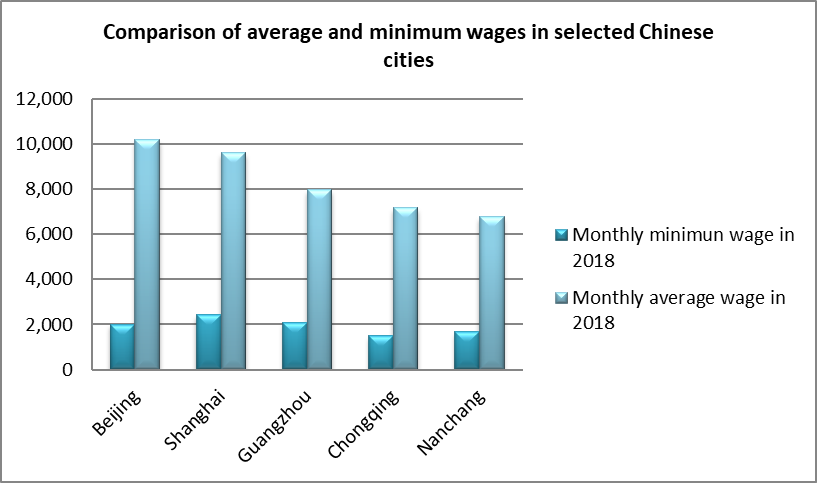
Income inequality
According to official government statistics for 2018, the average per capita disposable income of China’s richest 20 percent (70,640 yuan) was 11 times higher than the average income of the poorest 20 percent, which stood at just 6,440 yuan. While the annual average per capita disposable income of the richest 20 percent in China’s cities increased by nearly 20,000 yuan in the five years from 2013 to 2017, the disposable income of the poorest 20 percent in urban areas grew by less than 4,000 yuan (see chart below).
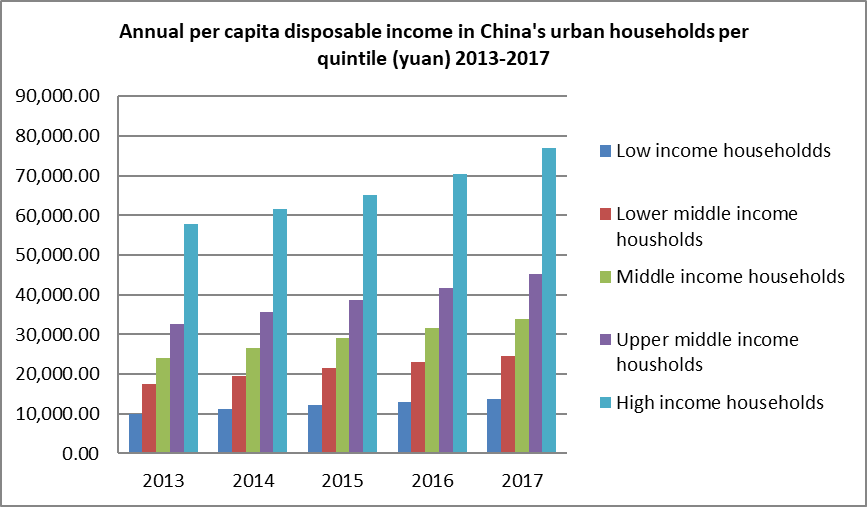
Looking further back, an examination of long-term income trends during the reform era in China conducted by Thomas Piketty, Li Yang and Gabriel Zucman showed that the top ten percent earners’ share of national income rose from 27 percent in 1978 to 41 percent in 2015, while the share of the bottom 50 percent dropped from 27 percent to just 15 percent. Piketty et al found moreover that while the average annual income growth in China was 6.2 percent from 1978 to 2015, income growth for the bottom 50 percent of the population was just 4.5 percent per year and income growth for the top one percent was nearly nine percent. The super wealthy, those in the top 0.001 percent of the population, saw incomes grow the fastest of all, increasing by 10.4 percent per annum on average. China had 338 billionaires in 2018, according to Forbes, with tech entrepreneur Jack Ma heading the list with a net worth of US$34.6 billion.
The wealth gap within China’s cities is still relatively small however when compared to the gap between the rural poor and the urban rich. In 2017, the average annual per capita disposable income of the richest 20 percent in urban areas (77,097.20 yuan) was 23 times higher than the average per capita disposable income of the poorest 20 percent in rural areas, which stood at just 3,301.90 yuan. As the chart below shows, incomes for the poorest rural residents have remained largely stagnant over the last decade as the gap with the richest urban residents continues to grow. The gap between the urban rich and rural poor was 22 times in 2010, for example, and about 21.5 times in 2005. Looking back to beginning of the reform era, Piketty et al found that the gap between urban to rural average incomes had risen from less than 200 percent in 1978 to about 350 percent in 2015.
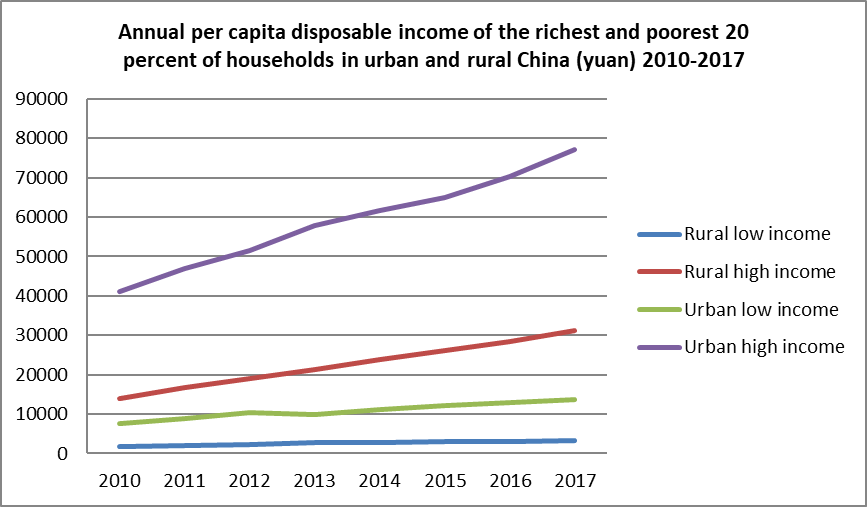
Source: China Statistical Yearbook 2015, 2018.
The urban-rural divide is probably the most important factor in wealth inequality in China today: Not simply because of the substantial income gap between rural and urban households but also because nearly all of China’s best healthcare, education, cultural and social services are located in urban areas. Whereas urban residents have reasonably unfettered access to such services, rural residents often have to pay excessive fees on top of the cost of travelling to and staying in the city that provides the services. Although smaller and, to some extent, medium-sized cities have begun to relax their administrative barriers to rural migration, there are no signs that major cities like Beijing, Shanghai and Guangzhou will make it easier for rural migrants to gain access to their jealously guarded social welfare, healthcare and education systems.
Analysis and conclusion
A superficial glance at China’s major cities seems to show a reasonably affluent society: young, hard-working middle class families, determined to make a better life for themselves. This illusion was shattered however in late 2017 when the municipal government of Beijing embarked on a 40-day high-profile campaign to clean out the city’s shanty towns and evict the so-called “low-end population” who produce, market, and deliver the goods, services and lifestyle products that Beijing’s middle class families aspire to. The evictions revealed the harsh truth that the affluence of China’s cities depends almost entirely on the impoverishment of the underclass.
The Chinese government has made the alleviation of poverty, fairer income distribution and the expansion of the middle class a high priority. General Secretary Xi Jinping stated in his address the 19th Party Congress in Beijing that:
We will expand the size of the middle-income group, increase income for people on low incomes, adjust excessive incomes, and prohibit illicit income. We will work to see that individual incomes grow in step with economic development, and pay rises in tandem with increases in labour productivity. We will expand the channels for people to make work-based earnings and property income. We will see that government plays its role in adjusting wealth redistribution, and moves faster to narrow the income gap and ensure equitable access to basic public services.
The speech however lacked any real concrete proposals on how these goals could be achieved, particularly in an economy that is now largely free from overt government controls.
One of the key reasons why low-wage earners have so far not been able to earn a decent income and bridge the gap to the middle class is because they lack the institutional means to bargain collectively for better pay and working conditions. Workers have demonstrated time and again over the last decade that they have the means and the ability or organize collectively, stage strikes and protests in response to specific labour rights violations. What they do not have however is a trade union that can represent them in collective bargaining with employers.
China’s sole legally mandated trade union, the All-China Federation of Trade Unions (ACFTU) has a titular presence in many workplaces but the union representatives are largely under the sway of management and have no real connection to ordinary workers. There is an increasing urgent need for China’s workers to assert more control over the union and make it more representative and effective. The Chinese government too will need to put pressure on the ACFTU to play its part in improving labour relations and maintaining long-term social, economic and political stability.
A version of this article was first published in 2008. It was last updated in March 2019.
